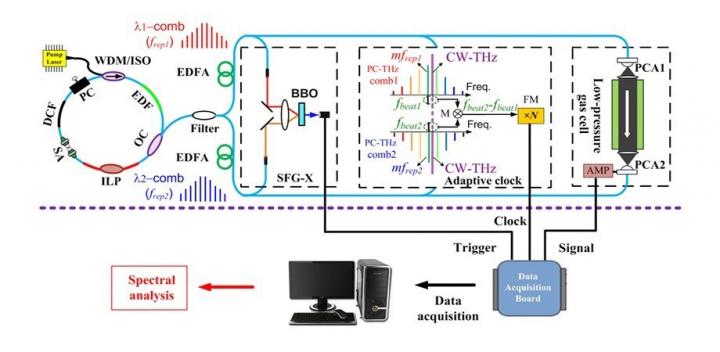Adaptive sampling technique offers exceptional resolution with only one laser source, half that of conventional systems

Credit: SPIE
Spectroscopy has roots in early 19th century curiosity about interactions between matter and electromagnetic radiation. Thanks to advances in electronics and materials science, various spectroscopy techniques are now routinely used to study the composition of materials and the nature of their chemical bonds by analyzing how they absorb or reflect electromagnetic waves.
Different materials have different absorption profiles across a wide range of frequencies. Some important features in certain molecular systems, like the hydrogen bonds in aqueous systems or the self-assembly of proteins, can be appreciated in their absorption profiles only at frequencies in the order of terahertz (THz, 1000 billion Hertz), a near-infrared range. Scientists have been actively developing spectroscopy techniques compatible with such high frequencies, and a promising one is called THz dual-comb spectroscopy.
Although this method offers many advantages over others in the terahertz range, its use has been limited because of the high complexity of the measurement system, which typically requires two independent stable lasers as the radiation sources. Now, researchers from Tokushima University, Japan, Beihang University, China, and Université du Littoral Côte d’Opale, France, have reported a novel scheme for THz dual-comb spectroscopy that requires only a single laser source while still providing exceptional resolution.
To understand the main aspects of their method, it helps to understand the basics of THz dual-comb spectroscopy. The term “dual-comb” refers to the fact that the laser pulses, when plotted versus frequency, look like a series of equally spaced spikes (spectral lines) over a broad frequency range in the terahertz region, and hence a “comb.” In dual-comb spectroscopy, two lasers with slightly different “combs” are used to measure the absorption profile of a sample. Because of the nature of the system, the signal that is actually measured, which results from the “mixing” of the two combs, occupies a much lower frequency range but still reflects all the high-frequency information of interest. The use of two lasers, however, can result in a problem with stabilization control.
To address the problem of stabilization, the researchers used a single laser to produce the two combs. However, when both combs are produced by the same laser source, a “jitter” or timing instability blurs the high-frequency information reflected in the final low-frequency signal that is measured. They corrected this undesirable phenomenon by using a technique called adaptive sampling, by which the signal to be digitally acquired is not sampled at equal time periods but at specific times calculated to minimize any drifts or errors in the relative timing between combs.
To demonstrate their method, the researchers carried out measurements on a mixture of air and the compound acetonitrile. This special gas exhibits characteristic features when irradiated with terahertz radiation and, most importantly, these features vary slightly with pressure. Because these variations are very small, previous dual-comb spectroscopy approaches using a single laser were unable to detect them due to their limited resolution. In contrast, the researchers could use the scheme proposed in this study to accurately observe many of these features. They report a remarkably narrow absorption linewidth (25 MHz) – the first achieved with a dual-comb fiber laser.
The researchers are already working on yet another complementary technique that could push the resolution of THz dual-comb spectroscopy with a single laser even further. The reduction in system complexity resulting from their use of the adaptive sampling technique could broaden the areas of application of precise THz spectroscopy, providing scientists with a powerful yet simple tool to further explore the material world.
###
Media Contact
Daneet Steffens
[email protected]
Related Journal Article
http://dx.




